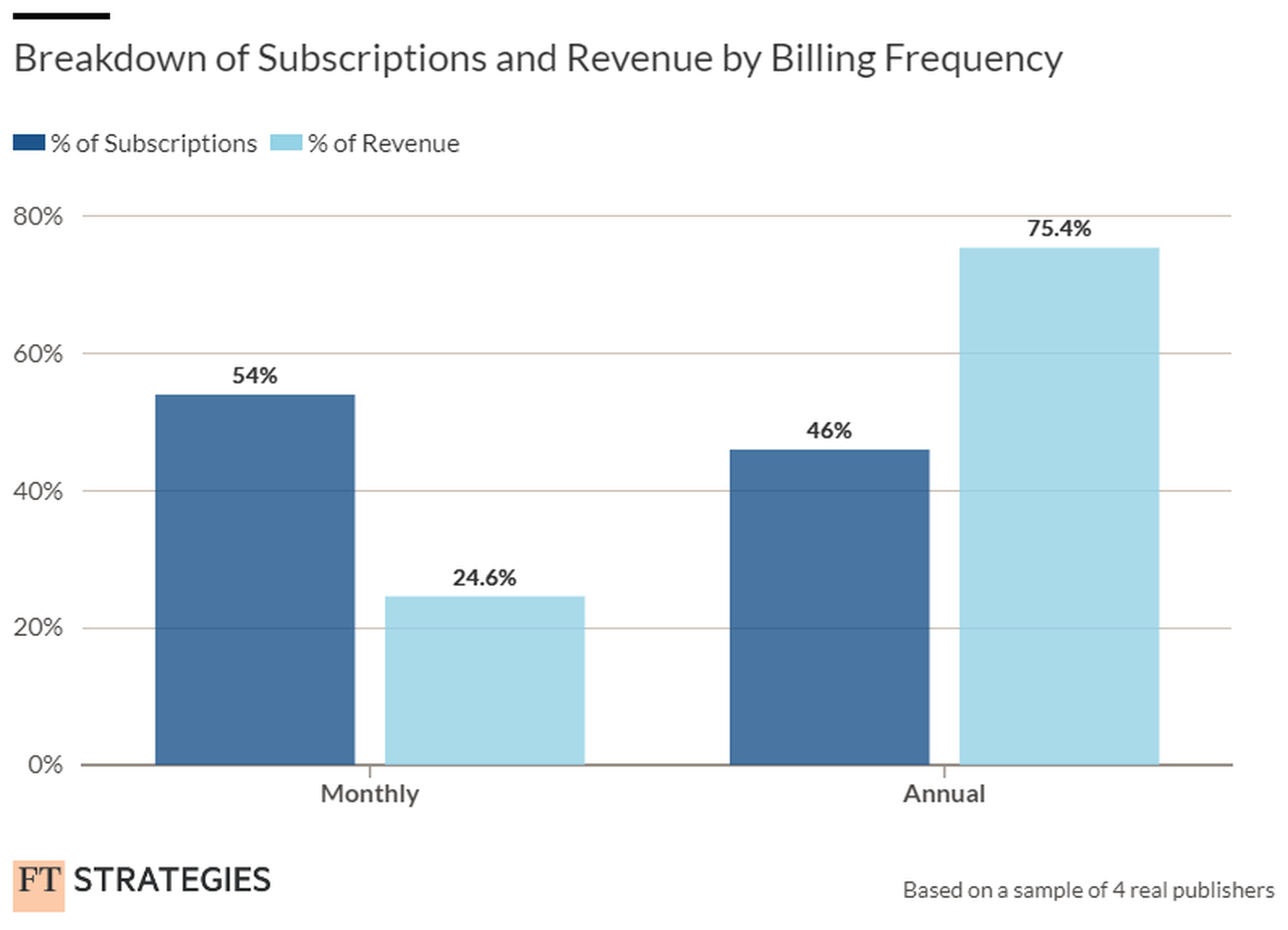A few weeks ago, we wrote an article and a follow-up LinkedIn post that sparked a necessary debate around the relationship between subscriber growth and revenue. Our argument, using a real yet extreme example, was that media organisations might be placing too great an emphasis on subscriber volume and not enough on the actual revenue generated from subscriptions. In our example, monthly subscribers made up a sizeable portion of the overall base (21%) but only generated 4% of total expected revenue in the first year due to high churn and cheap trial offers. Rightly, Greg Piechota from INMA pointed out that this does not align with median industry benchmarks, especially concerning the survival rate of monthly subscribers.
Based on this feedback, we felt it was important to widen our analysis and look at four more typical examples of news subscription companies in Europe to explore their experiences (whose anonymised data is used in the subsequent graphs).
As you can see from the graph below, this new sample sees a similar (albeit less extreme) phenomenon - monthly subscribers churn at a considerably higher rate than annual subscribers (40% of monthlies left after one year versus 64% annual). It is also worth noting that - especially for monthly subscribers - the median figure hides a relatively significant variance in the shape of the survival curves (which is why it is important to look beyond median benchmarks and analyse your own data).

These findings match up to those shared by Greg and Alexander Kreybig (from Piano) - a median 12-month survival rate for new monthly contracts is 34%, as opposed to 70% for new annual contracts. However, what is much more important than overall subscription numbers is subscription revenue. Looking at the data from the sample, we find a more balanced picture than the one that we originally shared; Monthly subscribers make up 54% of total subscribers with 46% being on an annual subscription. However, once you adjust for the higher churn rate and trial discounting, monthly subscribers make up just under 25% of the revenue with annuals contributing 75%.

But so what? As a few people argued, many brands simply have to offer monthly subscriptions because they accommodate for those who:
- Have lower brand awareness - they want to sample your product before committing to a long-term subscription;
- Have a desire for flexibility - they can cancel whenever they choose; and
- Have higher short-term price sensitivity - they cannot or are unwilling to pay a lump sum at the beginning of the subscription term
Although I agree with all of these points, I do think it is worth questioning our own assumptions. It is important because, as the Reuters Institute has found in their latest Digital News Report - “Across 20 countries, where a significant number of publishers are pushing digital subscriptions, payment levels have almost doubled since 2014 from 10% to 17%, but following a significant bump during the COVID pandemic, growth has slowed. Publishers have already signed up many of those prepared to pay, and converted some of the more intermittent payers to ongoing subscriptions or donations. But amid a cost-of-living crisis, it is proving difficult to persuade most of the public to do the same.”
So what should we do about it?
We encourage the clients that we work with to challenge their assumptions through targeted experiments. Here are just a few ideas that we have explored, with success, with previous clients:
Consider testing annual-only offers
Hide your monthly subscription option to a small portion of your total audience (e.g. 10%) and measure what happens. As opposed to exclusively measuring short-term conversion rates and performance, look at expected lifetime value for this cohort and compare it to your previous performance. Using the data above, it is possible to do some simple analysis to understand the balancing point.
Assuming you currently get 10,000 new subscribers per year - 5,400 are monthly (worth £24.60 per subscriber) and 4,600 are annual (worth £75.40 per subscriber). This equates to £479,680 in total revenue in year one.

If you are able to convert 33% of those would-be monthly subscribers to annual (1,800) and lose the remainder of monthlies then you would break even in revenue terms, despite acquiring 3,600 fewer subscribers per year (36% fewer). The table below shows a few different scenarios:

In practice, most organisations would hope that they could convert more than 33% of those who would normally opt for monthly to an annual offer making it a profitable initiative. That is the approach of some very high performing news organisations such as The Atlantic who have just hit 1 million subscribers. The same can be said for many telephone networks contracts who have thrived off the back of 18, 24 and 36 month contract terms that are billed on a monthly basis.
Consider how you might increase the proportion of annual subscribers
There are many ways that organisations can increase the proportion of annual subscribers:
- Reduce the prominence of your monthly offer via changes to landing pages
- Offer annual subscriptions with monthly payment terms (like a phone contract)
- Increase the discount for annual subscriptions
- Offer renewing monthly subscribers an annual subscription at a discount
Again, using the data above, we have created a few different scenarios with different assumptions:

In practice, organisations would hope that they could get a higher proportion of subscribers to opt for annual and see even greater returns in years 2 and 3 where churn rates continue to be much lower. For example, the Financial Times regularly experiments with deepening the discount on annual subscriptions (e.g. 33%) to encourage new customers to opt for that billing period as opposed to monthly. As part of that, we are very careful to evaluate the impact on expected customer lifetime value to ensure we are not leaving revenue on the table.
In summary, there is an opportunity for subscription organisations to centre themselves around subscription revenue, as opposed to overall subscriber numbers. Although that may present its own challenges (calculating estimated lifetime value, reducing conversion rates), there is research to suggest this may be the most sustainable approach. The industry has invested a significant amount of time and energy to convince people to pay for news media. Now is not the time to undermine those efforts.
How FT Strategies can help
We are very comfortable with conducting this type of analysis on behalf of clients - no matter how mature your subscription business is. That includes:
- Conducting pricing / proposition analysis
- Conjoint Analysis when (re)designing and pricing products
- Van Westendorp or Gabor-Granger when pricing existing products
- Evaluating promotions and billing periods
- Value proposition / product line-up redesign
We have helped hundreds of media organisations with their diversification strategies and subscriptions. Our consultants are experts in media business models and can deliver real impact for your organisation. Whether it’s commercial growth or strategy development, our consultants can apply their extensive experience and expertise to help you achieve your goals and outcomes.
If you'd like to discuss a project you have in mind, please do reach out to me directly - emanuele.porfiri@ft.com. Alternatively, If you’d like to learn more about our consultancy services, please reach out to us for more information.
About the authors

Emanuele Porfiri, Head of Analytics

Emanuele is Head of Analytics at FT Strategies and has worked with clients in developing engagement metrics, building data architectures and conducting business analyses and insights. He previously spent seven years at Realised UNLIMITED, a boutique analytics consultancy.

George Montagu, Head of Insights

George is the Head of Insights at FT Strategies and has contributed to a number of subscription-focused projects for leading European publishers. He previously spent 4 years guiding FT's data strategy and their approach to the future of marketing & advertising. Most recently, he has been working on a leading study to assess the sustainability of news publishers across the globe. George also holds an MBA from IE Business School and is a regular speaker at publishing events.

Nathan McCurdy, Intern

Nathan is an intern at FT Strategies specialising in data analysis and other statistics-related projects. Nathan is currently completing his Economics and Statistics degree at Grinnell College in Iowa.
